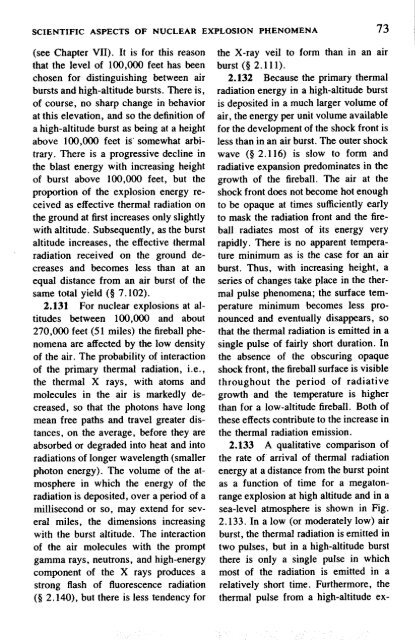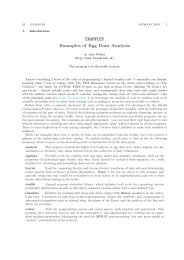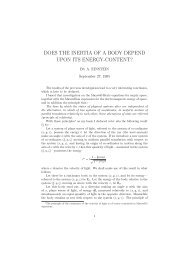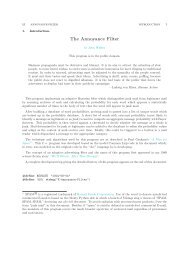Create successful ePaper yourself
Turn your PDF publications into a flip-book with our unique Google optimized e-Paper software.
SCIENTIFIC ASPECTS OF NUCLEAR EXPLOSION PHENOMENA 73(see Chapter VII). It is for this reason the X-ray veil to form than in an airthat the level of 100,000 feet has been burst (§ 2.111).chosen for distinguishing between air 2.132 Because the primary thermalbursts and high-altitude bursts. There is, radiation energy in a high-altitude burstof course, no sharp change in behavior is deposited in a much larger volume ofat this elevation, and so the definition of air, the energy per unit volume availablea high-altitude burst as being at a height for the development of the shock front isabove 100,000 feet is somewhat arbi- less than in an air burst. The outer shocktrary. There is a progressive decline in wave (§ 2.116) is slow to form andthe blast energy with increasing height radiative expansion predominates in theof burst above 100,000 feet, but the growth of the fireball. The air at theproportion of the explosion energy re- shock front does not become hot enoughceived as effective thermal radiation on to be opaque at times sufficiently earlythe ground at first increases only slightly to mask the radiation front and the firewithaltitude. Subsequently, as the burst ball radiates most of its energy veryaltitude increases, the effective thermal rapidly. There is no apparent temperaradiationreceived on the ground de- ture minimum as is the case for an aircreases and becomes less than at an burst. Thus, with increasing height, aequal distance from an air burst of the series of changes take place in the thersametotal yield (§ 7.102).mal pulse phenomena; the surface tem-2.131 For nuclear explosions at al- perature minimum becomes less protitudesbetween 100,000 and about nounced and eventually disappears, so270,000 feet (51 miles) the fireball phe- that the thermal radiation is emitted in anomena are affected by the low density single pulse of fairly short duration. Inof the air. The probability of interaction the absence of the obscuring opaqueof the primary thermal radiation, i.e., shock front, the fireball surface is visiblethe thermal X rays, with atoms and throughout the period of radiativemolecules in the air is markedly de- growth and the temperature is highercreased, so that the photons have long than for a low-altitude fireball. Both ofmean free paths and travel greater dis- these effects contribute to the increase intances, on the average, before they are the thermal radiation emission.absorbed or degraded into heat and into 2.133 A qualitative comparison ofradiations of longer wavelength (smaller the rate of arrival of thermal radiationphoton energy). The volume of the at- energy at a distance from the burst pointmosphere in which the energy of the as a function of time for a megatonradiationis deposited, over a period of a range explosion at high altitude and in amillisecond or so, may extend for sev- sea-level atmosphere is shown in Fig.eral miles, the dimensions increasing 2.133. In a low (or moderately low) airwith the burst altitude. The interaction burst, the thermal radiation is emitted inof the air molecules with the prompt two pulses, but in a high-altitude burstgamma rays, neutrons, and high-energy there is only a single pulse in whichcomponent of the X rays produces a most of the radiation is emitted in astrong flash of fluorescence radiation relatively short time. Furthermore, the(§ 2.140), but there is less tendency for thermal pulse from a high-altitude ex-










